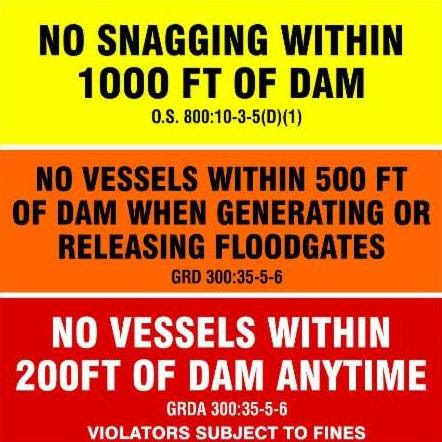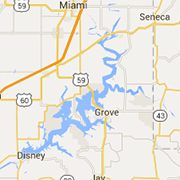August 7 GRDA Weekly Report
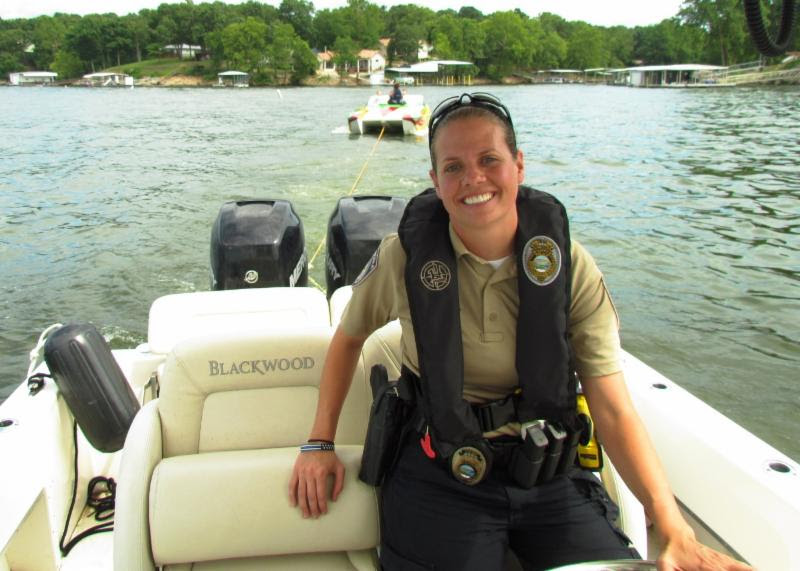
Staying Safe While Swimming in Our Lakes and Rivers, Part 1

Swimming in our area lakes and rivers are a popular recreational pastime, and can be done safely at designated swimming areas that are protected by lifeguards. But the fact is that there are few public swimming areas that are staffed by trained life guards, so it is incumbent on us to know the rules of how to swim in open waters and stay safe. Swimming in a natural body of water is different from swimming in a pool. More skills and energy are required for natural water environments because of cold water and air temperatures, currents, waves, wakes and other conditions that are subject to change with the weather.
Life jackets are not just for boating, but should always be used any time you are near the water on the shoreline. Many people involved in aquatic emergencies never intended to swim in the first place. Whenever you are around the water, take the steps to prepare for the unexpected, such as wearing a US Coast Guard approved life jacket.
The fact is, that many of the drowning deaths that are investigated by GRDA Police occur due to people falling in the water while working or playing on docks, or from falling in along the shore or while wading in what they thought was shallow water. Use life jackets whenever you are close to the water and ensure it is properly fitted to the user. A variety of hazards typically exist under the water that you may not see. The rule to follow is, if you can’t see your toes, wear a life jacket! What is presumed to be shallow water, can suddenly drop in depth and there are also slip and trip hazards under the water you will never see.
Always stay aware of water and weather conditions. Whenever you are near a natural water environment, look out for unexpected changes in air or water temperature, fast-moving currents, waves and rapids, even while in shallow waters. Hazards such as dams, underwater obstacles, rocks or debris moving on the surface can send you underwater in seconds. Aquatic life such as vegetation could entangle your feet or animals that live in or near the water can startle you, resulting in a fall.
Make smart choices by planning ahead and staying informed to keep everyone in your group safe. Be aware of potential hazards of the area you are visiting and take appropriate precautions. Check water and weather conditions before your trip and frequently during the day. Watch for signs of severe weather and leave the water at the first indication of thunder or lightning. In the event of a storm, stay inside an enclosed area for at least 30 minutes after the last thunder or lightning. If outside, avoid open areas, tall, isolated trees or metal objects.
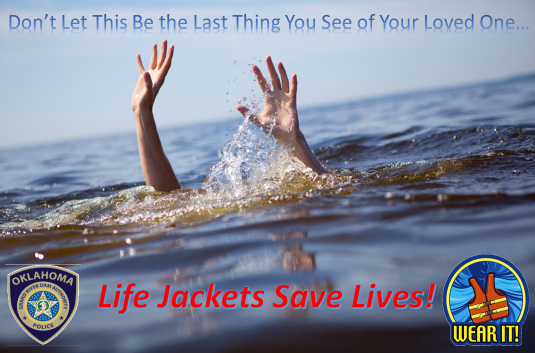
Operation Dry Water
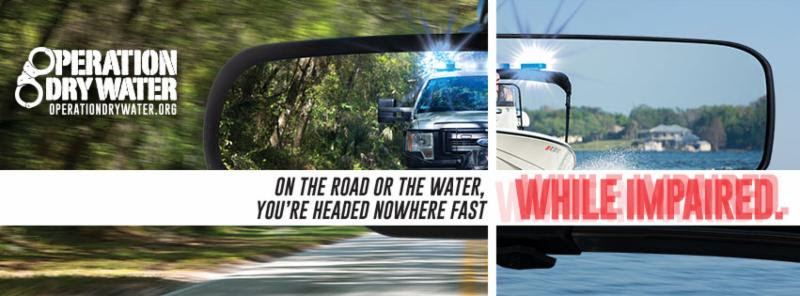
Restricted Areas at Kerr Dam

|
|
Yellow = No Snagging
Orange = No Entry While Releasing or Generating
Red = No Entry
|
Learning from the Branson Tragedy

Officials in Branson were able to complete the recovery of the Duck that sank in 80 feet of water on Table Rock Lake. Life jackets can still been seen hanging from the overhead compartment of the vessel as it was pulled from the water.
We have all heard the news reports and seen the devastating video of the watercraft that capsized and sank on Table Rock Lake in Branson recently. While the results of the official investigations will not be completed for some time, there were some obvious factors that contributed to the cause of this event that took the lives of seventeen people. These factors are present in many boating incidents that we see as Lake Police Officers, but do not garner the attention of the national news because of the scale of the devastation. But the fact is that lives can be saved by learning from these incidents. Granted, we do not have the type of commercial vessels operating on our lakes that carry the number of passengers that were on board the tourist “Duck” vessel that was involved in Branson, but there are a number of boats of greater size on our lakes that can and do carry more passengers than what was involved in this event.
History has shown that we can and will have similar incidents on our waters, but they typically occur on a smaller scale. The loss of one life is too much, particularly if it can be avoided. The contributing factors of this incident establish the perfect example of what can happen that we regularly warn boaters to protect themselves from. History will be repeated, if we fail to learn from past mistakes.
Weather is a powerful force, and regardless of the size of your vessel or how good a captain you are, there are times that you should just not be on the water. Powerful storms can quickly blow up and fall apart this time of year, which was obvious in the video of this particular event. A typical summertime thunderstorm can easily whip up sixty mile per hour winds, and the downdrafts created by these storms as they fall apart can generate hurricane force winds of 70-80 mph. When on the water, this can mean you are facing three to five foot white caps that can quickly swamp even larger vessels. Wave after wave over your bow will rapidly overpower your bilge pump, resulting in the listing of your boat and loss of the engine and steering control. As the high winds blow your bow away from the winds and waves, the side of your boat will be exposed to the dangerous conditions and your vessel can soon capsize from the force of the winds and high waves, sending you and your passengers into the turbulent waters. How do we know this? We’ve seen it happen! Any vessel, regardless of size is vulnerable to what Mother Nature can throw at it. Weather is too unpredictable to dismiss. When you see the weather turn ugly, even at a distance, that’s the time to head for a marina or even the safety of a private slip to ride out the storm.
Even in the calmest of conditions, anybody that has operated a boat has encountered the “Rogue Wave” they did not expect that nearly threw you and your passengers out of your boat. With vessels of over 100 feet in length on our lakes, there is no doubt that you can encounter enormous wakes that travel great distances that can swamp smaller boats if you are not ready for it. Overloading your boat with passengers and cargo will increase your risk of swamping, so adhere to the manufacturers specifications for the amount of weight you carry or you could pay dearly for that mistake.
Like a seat belt, the life jacket you have stowed away in a compartment is of no value in saving your life if it is not used. We typically find boaters that keep their life jackets stowed away in bags in a cabin or a compartment on the boat. Do you really think you will have the time to find that stowed life jacket when you most need it? What if you are ejected from the vessel? The life saving devices must be readily accessible, as required by law. Take it out of the compartment, make sure it is properly fitted to you and keep it within your reach while the vessel is underway. Better yet, WEAR IT! Inflatable life jackets are a perfect solution because they are light, comfortable and easy to wear.
Why did the people on board the Duck not wear life jackets? Because Coast Guard regulations do not require they be worn on any vessel over 26 feet in length. But, as we have seen in this tragedy, any size vessel can sink. We encounter this reasoning for not wearing life jackets often. But do you think a child can fall overboard from a boat that is greater than 27 feet? Life jackets save lives, but only if they are used. Just ask one of the survivors of the Missouri incident who said “If I was able to get a life jacket, I could have been able to save my babies”.
ATS Readies for Fall Cleanup

The Adopt the Shoreline program on Grand Lake is ready to begin the Fall 2018 cleanup programs in September.
106 TONS of trash and debris has been removed from Lady Grand so far in 2018!
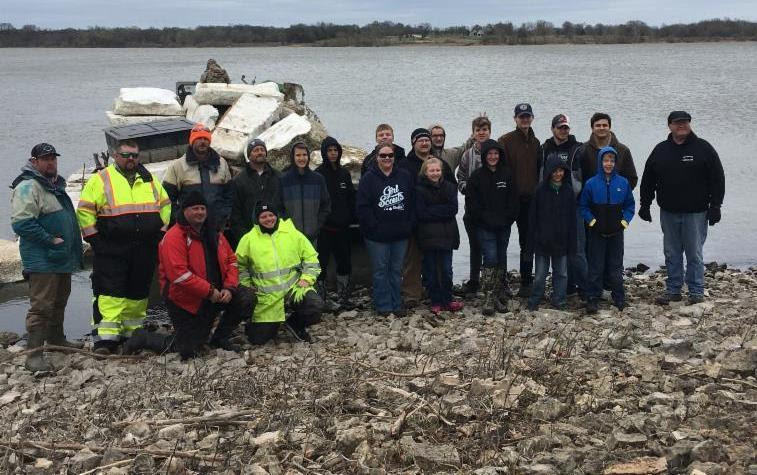
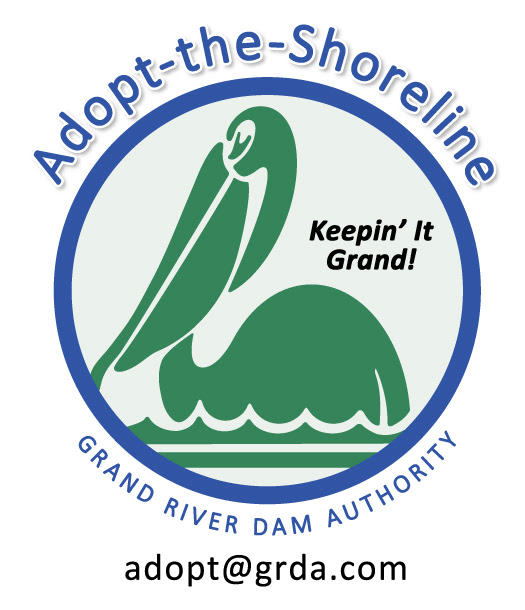
WoodStock On The Water

Did You Know?

True or False: I have family visiting and we will be going over recommended boat passenger capacity by just one person. This shouldn’t be a problem for safe boating, right?
Answer: False. It can be a fatal mistake to overload your boat. To ensure boater safety for everyone on board, be sure to check your boat’s capacity plate to see what the maximum number of people or carrying weight in pounds is.
Illinois River
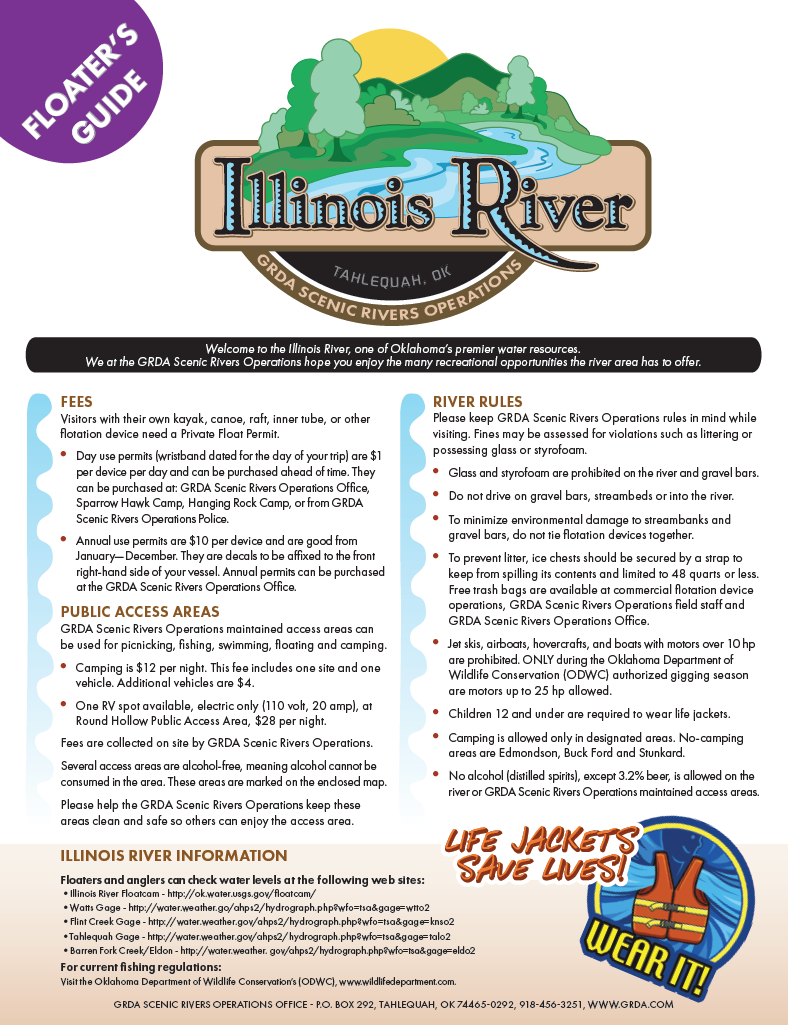

A Familiar Spot for a Grand Lake

Over the last several years, it has become common for Grand Lake to be listed among the best fisheries in the nation. That streak held true again recently when Bassmaster magazine released its annual list of the “100 best bass lakes in America” and, coming in at 13th in the Central United States, was a familiar name: Grand Lake. In fact, since 2012, the lake has always held pretty steady somewhere in the top 20.
According to the magazine, the process to rank the nation’s best bass fisheries takes several months. Yearly data from fisheries agencies and tournament results from all across the country are collected, compiled and discussed by a panel of fishing industry experts that eventually settles on the final rankings.
As a two-time host of the prestigious Bassmaster Classic as well as many other tournaments on an annual basis, Grand Lake’s reputation among anglers was already strong. However, that reputation was not built on its own. Instead, it has taken several years of work, education/outreach efforts and of course, plenty of cooperation with area anglers and other agencies that also care for the waters of Grand Lake. It all adds up to annual recognition for a special lake that has been welcoming anglers, boaters, swimmers, sailors and visitors of all kinds since 1940.
For GRDA those efforts continue on. Ongoing water quality monitoring, shoreline cleanup efforts (including the new Adopt the Shoreline Program) and Rush for Brush are just some of the ways GRDA is committed to caring not only for the fisheries but also for the waters all along the Grand River watershed.
Being a good steward of the natural resources under its control is an ongoing GRDA mission.
"Updates" on the Web

Did you not receive our latest GRDA Update? Do you have a friend that wants to see our Updates? You can now go to our website at GRDA.com to view the latest edition of GRDA Police Updates. Go to the Lakes/River tab, open the GRDA Police tab and click on the GRDA Police Update for the latest version of our email release.
Boating Tips From the GLSPS

A boater should always be alert and take the appropriate action when approaching boat wakes. Larger wakes can unseat people on the boat resulting in possible injury, dislodge items tossing them around and even damage your boat. To stay safe and make the ride more comfortable for those on your boat, position your boat as far away as is safely possibly from the path of the other boat to minimize impact. Turn into the wake just before you reach it at about a 45 degree angle and reduce throttle. Once you have crossed the wake, turn back toward your original course and speed.
With the larger boats on Grand Lake, it is not uncommon to encounter large wakes and multiple waves when boating. Always take wakes at an angle for better comfort. It may vary from 10 to 45 degrees depending on the wake’s size. When encountering multiple large waves on the lake, there is a risk of running down the back side of one and burying the bow in the front side of the next one. If it appears the bow will hit and possibly bury, immediately throttle back. If no action is taken, the boat could continue to submarine under the wave and be swamped. A good rule is one hand on the steering wheel and one on the throttle. Always be alert for wakes and remember when crossing a large boat’s wake, the further you are away from the boat, the less severe is the wake. Changing your course temporarily until passing the wakes can be more comfortable for your passengers and easier on your boat.
Interested in becoming more confident in your boating skills? Boat Smart from the start and take a course from America’s Boating Club, the United States Power Squadrons. For local information visit our website at: usps.org/grandlake or on Face Book at GLSPS.
NAV TIME

A Summary of Boating Laws, Navigation Regulations & Tips
That All Boat Operators Should Know
Encountering Vessels at Night
When you see only a white light, you are overtaking another vessel. It is the stand-on vessel whether it is underway or anchored. You may go around it on either side.

Encountering only a white light
When you see a green and a white light, you are the stand-on vessel. However, remain alert in case the other vessel operator does not see you or does not know the navigation rules.
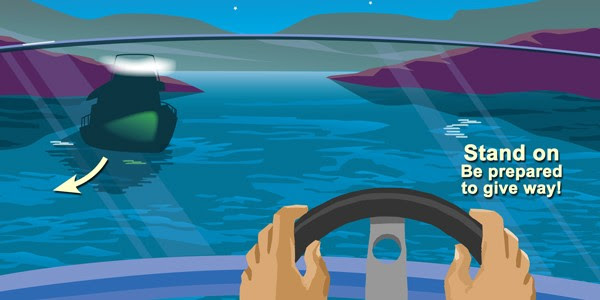
Encountering a green and a white light
When you see a red and a white light, you must give way to the other vessel! Slow down and allow the vessel to pass, or you may turn and pass behind the other vessel.
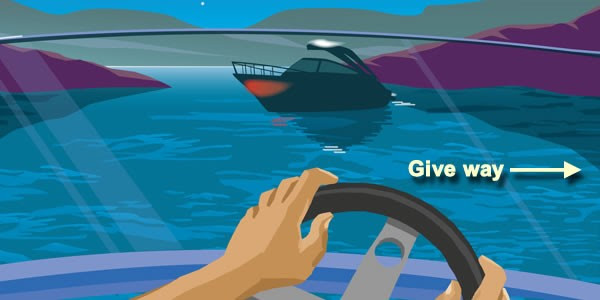
Encountering a red and a white light
By the Book

The Administrative Regulations of GRDA describe the organizations, operations, and procedures for the Grand River Dam Authority with respect to its administration, rulemaking, and other activities and are intended to supplement and interpret pertinent provisions of state statutes.
The following information are excerpts of the GRDA Administrative Regulations Title 300 Chapter 35 that are provided in an effort to educate the public about what regulations are enforced on GRDA waterways and properties. Many of these regulations have changed effective September 11, 2017. All GRDA regulations are available for review at GRDA.com.





